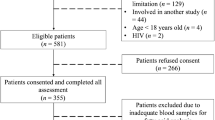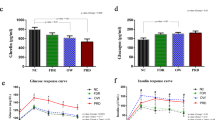Abstract
Background/Objectives:
Plasma leptin and adiponectin, and membrane phospholipid fatty acid composition are implicated into the mechanism of insulin resistance but no clear pattern has emerged. Hence, this study examined these variables in subjects presenting to the diabetic clinic for a diagnostic glucose tolerance test.
Subjects/Methods:
Body composition, glucose, glycated hemoglobin, insulin, leptin, adiponectin, and red cell and plasma phospholipid fatty acids were assessed from 42 normal and 28 impaired glucose tolerant subjects. Insulin sensitivity was determined by homeostatic model assessment.
Results:
The plasma phosphatidylcholine fatty acid composition of the impaired glucose tolerant subjects was similar to that of normal subjects. However, the impaired glucose tolerant subjects had significantly lower linoleic (P<0.05), eicosapentaenoic (P<0.05) and docosahexaenoic (P<0.01) acids in the red cell phosphatidylcholine and phosphatidylethanolamine compared with the normal subjects. Moreover, red cell phosphatidylcholine docosahexaenoic acid correlated positively with adiponectin (r=0.290, P<0.05) but negatively with leptin (r=−0.252, P<0.05), insulin (r=−0.335, P<0.01) and insulin resistance (r=−0.322, P<0.01). Plasma triglycerides, leptin and glucose combined predicted about 60% of variation in insulin level whereas insulin was the only component that predicted the membrane fatty acids.
Conclusions:
We postulate that membrane phospholipids fatty acids have an indirect role in determining insulin concentration but insulin has a major role in determining membrane fatty acid composition.
This is a preview of subscription content, access via your institution
Access options
Subscribe to this journal
Receive 12 print issues and online access
$259.00 per year
only $21.58 per issue
Buy this article
- Purchase on Springer Link
- Instant access to full article PDF
Prices may be subject to local taxes which are calculated during checkout
Similar content being viewed by others
References
Allen HG, Allen JC, Boyd LC, Alston-Mills BP, Fenner GP (2006). Determination of membrane lipid differences in insulin resistant diabetes mellitus type 2 in whites and blacks. Nutrition 22, 1096–1102.
Almeida-Pititto BD, Gimeno SG, Sanudo A, Ribeiro-Filho FF, Ferreira SR, Japanese-Brazilian Diabetes Study Group (2005). Leptin is associated with insulin resistance in Japanese migrants. Metab Syndr Relat Disord 3, 140–146.
Aurora R, Gothard P, Thomas B, Lowy C, Min Y, Ghebremeskel K (2005). High dose of MaxEPA treatment reduces fat mass of diet-treated type 2 diabetic patients. 23rd International Symposium on Diabetes and Nutrition. Ebeltoft: Denmark (abstract).
Banga A, Unal R, Tripathi P, Pokrovskaya I, Owens RJ, Kern PA et al. (2009). Adiponectin translation is increased by the PPARgamma agonists pioglitazone and omega-3 fatty acids. Am J Physiol Endocrinol Metab 296, E480–E489.
Clore JN, Harris PA, Li J, Azzam A, Gill R, Zuelzer W et al. (2000). Changes in phosphatidylcholine fatty acid composition are associated with altered skeletal muscle insulin responsiveness in normal man. Metabolism 49, 232–238.
Considine RV, Sinha MK, Heiman ML, Kriauciunas A, Stephens TW, Nyce MR et al. (1996). Serum immunoreactive-leptin concentrations in normal-weight and obese humans. N Engl J Med 334, 292–295.
Dang AQ, Faas FH, Jethmalani SM, Carter WJ (1991). Decreased incorporation of long-chain fatty acids into erythrocyte phospholipids of STZ-D rats. Diabetes 40, 1645–1651.
Delarue J, LeFoll C, Corporeau C, Lucas D (2004). N-3 long chain polyunsaturated fatty acids: a nutritional tool to prevent insulin resistance associated to type 2 diabetes and obesity? Reprod Nutr Develop 44, 289–299.
Esteghamati A, Khalilzadeh O, Anvari M, Rashidi A, Mokhtari M, Nakhjavani M (2009). Association of serum leptin levels with homeostasis model assessment-estimated insulin resistance and metabolic syndrome: The key role of central obesity. Metab Synd Relat Disord 7, 447–452.
Fickova M, Hubert P, Crémel G, Leray C (1998). Dietary (n-3) and (n-6) polyunsaturated fatty acids rapidly modify fatty acid composition and insulin effects in rat adipocytes. J Nutr 128, 512–519.
Field CJ, Ryan EA, Thomson AB, Clandinin MT (1990). Diet fat composition alters membrane phospholipid composition, insulin binding, and glucose metabolism in adipocytes from control and diabetic animals. J Biol Chem 265, 11143–11150.
Fisher FM, McTernan PG, Valsamakis G, Chetty R, Harte AL, Anwar AJ et al. (2002). Differences in adiponectin protein expression: effect of fat depots and type 2 diabetic status. Horm Metab Res 34, 650–654.
Flachs P, Rossmeisl M, Bryhn M, Kopecky J (2009). Cellular and molecular effects of n-3 polyunsaturated fatty acids on adipose tissue biology and metabolism. Clin Sci (Lond) 116, 1–16.
Folch J, Lees M, Sloane Stanley GH (1957). A simple method for the isolation and purification of total lipides from animal tissues. J Biol Chem 226, 497–509.
Friedman JM, Halaas JL (1998). Leptin and the regulation of body weight in mammals. Nature 395, 763–770.
Guebre-Egziabher F, Rabasa-Lhoret R, Bonnet F, Bastard JP, Desage M, Skilton MR et al. (2008). Nutritional intervention to reduce the n-6/n-3 fatty acid ratio increases adiponectin concentration and fatty acid oxidation in healthy subjects. Eur J Clin Nutr 62, 1287–1293.
Itoh M, Suganami T, Satoh N, Tanimoto-Koyama K, Yuan X, Tanaka M et al. (2007). Increased adiponectin secretion by highly purified eicosapentaenoic acid in rodent models of obesity and human obese subjects. Arterioscler Thromb Vasc Biol 27, 1918–1925.
Kamboj SS, Chopra K, Sandhir R (2009). Hyperglycemia-induced alterations in synaptosomal membrane fluidity and activity of membrane bound enzymes: beneficial effect of N-acetylcysteine supplementation. Neuroscience 162, 349–358.
Kuypers FA (2007). Membrane lipid alterations in hemoglobinopathies. Hematology Am Soc Hematol Educ Program 68–73.
Le Petit-Thévenin J, Nobili O, Boyer J (1988). Decreased acylation of phosphatidylcholine in diabetic rat erythrocytes. Diabetes 37, 142–146.
Maffei M, Halaas J, Ravussin E, Pratley RE, Lee GH, Zhang Y et al. (1995). Leptin levels in human and rodent: measurement of plasma leptin and ob RNA in obese and weight-reduced subjects. Nat Med 1, 1155–1161.
Makar TK, Hungund BL, Cook GA, Kashfi K, Cooper AJ (1995). Lipid metabolism and membrane composition are altered in the brains of type II diabetic mice. J Neurochem 64, 2159–2168.
Min Y, Ghebremeskel K, Lowy C, Thomas B, Crawford MA (2004). Adverse effect of obesity on red cell membrane arachidonic and docosahexaenoic acids in gestational diabetes. Diabetologia 47, 75–81.
Min Y, Nam JH, Ghebremeskel K, Kim A, Crawford M (2006). A distinctive fatty acid profile in circulating lipids of Korean gestational diabetics: a pilot study. Diab Res Clin Pract 73, 178–183.
Nakamura Y, Ueshima H, Okuda N, Higashiyama A, Kita Y, Kadowaki T et al. (2008). Relation of dietary and other lifestyle traits to difference in serum adiponectin concentration of Japanese in Japan and Hawaii: the INTERLIPID Study. Am J Clin Nutr 88, 424–430.
Neschen S, Morino K, Rossbacher JC, Pongratz RL, Cline GW, Sono S et al. (2006). Fish oil regulates adiponectin secretion by a peroxisome proliferator-activated receptor-gamma-dependent mechanism in mice. Diabetes 55, 924–928.
Nishida M, Funahashi T, Shimomura I (2007). Pathophysiological significance of adiponectin. Med Mole Morphol 40, 55–67.
Pérez-Matute P, Marti A, Martínez JA, Fernández-Otero MP, Stanhope KL, Havel PJ et al. (2005). Eicosapentaenoic fatty acid increases leptin secretion from primary cultured rat adipocytes: role of glucose metabolism. Am J Physiol Regul Integr Comp Physiol 288, R1682–R1688.
Ramel A, Parra D, Martinéz JA, Kiely M, Thorsdottir I (2009). Effects of seafood consumption and weight loss on fasting leptin and ghrelin concentrations in overweight and obese European young adults. Eur J Nutr 48, 107–114.
Roelofsen B, Zwaal RFA (1976). The use of phospholipases in the determination of asymmetric phospholipid distribution in membranes. Meth Membr Biol 7, 147–177.
Rossi AS, Lombardo YB, Lacorte JM, Chicco AG, Rouault C, Slama G et al. (2005). Dietary fish oil positively regulates plasma leptin and adiponectin levels in sucrose-fed, insulin-resistant rats. Am J Physiol Regul Integr Comp Physiol 289, R486–R494.
Selenscig D, Rossi A, Chicco A, Lombardo YB (2010). Increased leptin storage with altered leptin secretion from adipocytes of rats with sucrose-induced dyslipidemia and insulin resistance: effect of dietary fish oil. Metabolism 59, 787–795.
Spranger J, Kroke A, Möhlig M, Bergmann MM, Ristow M, Boeing H et al. (2003). Adiponectin and protection against type 2 diabetes mellitus. Lancet 361, 226–228.
Verkleij AJ, Zwaal RF, Roelofsen B, Comfurius P, Kastelijn D, van Deenen LL (1973). The asymmetric distribution of phospholipids in the human red cell membrane. A combined study using phospholipases and freeze-etch electron microscopy. Biochim Biophys Acta 323, 178–193.
WHO (2006). Definition and diagnosis of diabetes mellitus and intermediate hyperglycaemia: Report of a WHO/IDF consultation. WHO Document Production Services: Geneva, Switzerland.
Acknowledgements
The financial support of the Guy's and St Thomas’ Charity (Endocrine and Diabetic Fund), The Letten Foundation, The Foyle Foundation, The Mother and Child Foundation, and FP6 Marie Curie Actions - Transfer of Knowledge (MTKD-CT-2005-029914) is gratefully acknowledged. We thank all participants and Miss Sonja Tait, Miss Virginie Alexandre and Dr Julia Geppert for their technical assistance.
Author information
Authors and Affiliations
Corresponding author
Ethics declarations
Competing interests
The authors declare no conflict of interest.
Rights and permissions
About this article
Cite this article
Min, Y., Lowy, C., Islam, S. et al. Relationship between red cell membrane fatty acids and adipokines in individuals with varying insulin sensitivity. Eur J Clin Nutr 65, 690–695 (2011). https://doi.org/10.1038/ejcn.2011.19
Received:
Revised:
Accepted:
Published:
Issue Date:
DOI: https://doi.org/10.1038/ejcn.2011.19
Keywords
This article is cited by
-
Dietary n-3 polyunsaturated fatty acids modify fatty acid composition in hepatic and abdominal adipose tissue of sucrose-induced obese rats
Journal of Physiology and Biochemistry (2011)



